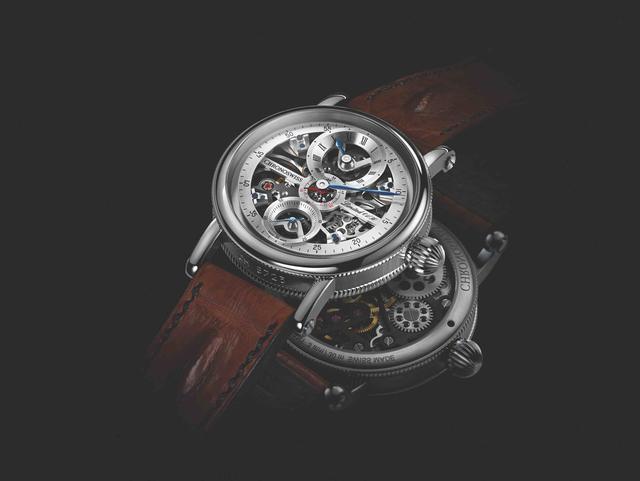As it celebrates its 35th anniversary, Chronoswiss introduces five new regulators in an ode to its historic technical specialty.
From the very start, Chronoswiss stood apart among independent watchmakers. Founded in 1983 not in Switzerland but in Munich by German watchmaker Gerd-Rüdiger Lang, Chronoswiss defied the quartz wave of its era to focus only on mechanical watches.

Flying Regulator Night and Day in rose gold
After primarily offering chronographs made with vintage mechanical movements, Lang very quickly began to emphasize the regulator display; a fairly archaic dial layout that emphasizes a large central minute hand, with the hour and seconds hands in smaller subdials aligned between the 12 and the 6.
Regulator dials were well known as a display used on clocks. Watchmakers within ateliers consulted such clocks, often centrally located in the front of the workshop, as they regulated watches they were making. But until Chronoswiss created its manual-wind Regulator (spelled Régulateur in French) in 1987, and officially debuted it in 1988, no watchmaking company had serially produced such a dial configuration for a wristwatch collection.

Flying Regulator Open Gear, black dial
Clear casebacks
Lang also garnered accolades – and the occasional sideway glance from purists – for placing a clear sapphire or mineral crystal on the back of his watches. While the clear caseback is today taken for granted and indeed demanded by collectors, Chronoswiss was the first company to regularly provide this view to its customers. Lang in fact placed such casebacks on his watches as early as 1982.
But it was the novelty – and success – of its first Regulator that defined Chronoswiss’ rise within the collector community. That initial demand led Chronoswiss to make an automatic version several years later, followed by multiple regulator iterations in the decades since.

Flying Regulator Night and Day, black dial
Chronoswiss also began making equally compelling mechanical watches with more traditional dials. Each offered a new take on a classic complication, and all of them appealed to classic watch lovers. Its style then, and now, almost always includes watches with engraved dials, coin-edged bezels, screwed lugs and onion-style crowns. Enamel and engraved dials are also a specialty within the company.
Sporty models like the Chronoswiss Timemaster boasted even larger onion-shaped crowns that recall those used on vintage racing and aviation watches. And from the very start of the brand, Chronoswiss has drawn from an enviable cache of vintage Enicar 165 movements to create custom calibers for many of its best-known models. In addition, many of its best-known movements start as solid ETA Valjoux and Unitas base calibers, which Chronoswiss upgrades and, often, skeletonizes.

The 44mm Chronoswiss Flying Grand Regulator Limited Edition, in steel
The Chronoswiss Opus, which debuted in 1995, for example, was probably the first skeletonized automatic chronograph wristwatch, while the Kairos Chronograph offered a rare off-centered display. The Chronoswiss Delphis, meanwhile, was the first wristwatch to combine analog, digital and retrograde displays.
Latest Regulators
Next to the clear caseback, the regulator dial has become Chronoswiss’ most emulated innovation. And even as many other watchmakers began to create their own regulator dials, Chronoswiss moved ahead, devising a host of watches based on the regulator concept. These newer Regulator watches typically host classic functions and appear in several case shapes.

The new Chronoswiss Flying Grand Regulator Limited Edition features a complex multi-level dial with galvanic black or red varnish with guilloche pattern.
Over the years Chronoswiss has, for example, combined its Regulator with a chronograph, a tourbillon, within skeleton models, using digital hour indication, framed by rectangular cases and even as a pocket watch.
Since the regulator watch is so closely linked with its history, Chronoswiss this year celebrates the 30th anniversary of the Chronoswiss Regulator with a series of new Regulator designs. In addition, Chronoswiss itself turns 35 this year, which means there’s yet another reason to celebrate.

Chronoswiss Flying Regulator Open Gear Anniversary Edition is limited to 35 pieces in steel and red gold
Chronoswiss, therefore, has created five anniversary presents for its collectors, and all of them are new Regulator watches. One new model, which debuted this year at Baselworld, is the Flying Regulator Open Gear Anniversary.
“With the limited Flying Regulator Open Gear Anniversary Edition, we are celebrating our 35-year history with it– hence the red 35 on the minute scale – and simultaneously honoring its bestselling model,” explains Chronoswiss CEO Oliver Ebstein.

Flying Regulator Open Gear Anniversary Edition, in red gold
“The anniversary watch’s unusual design is a play on the regulator theme itself, placing it front and center with our “Open Gear” design. The dial is simultaneously its module board, onto which the train wheel bridges of the skeletonized gears are mounted.”
Another of these celebratory models, the Flying Grand Regulator Skeleton Limited Edition, which appears on the cover of the Summer issue of iW, combines several emblematic Chronoswiss features, the regulator and a skeletonized movement, in one limited edition series. You’ll see images and descriptions of all five new Chronoswiss regulator watches in this post.

The Chronoswiss Flying Grand Regulator Skeleton Limited Edition, front and back
Continuing the legacy
Ebstein, the businessman who with his wife Eva Marie purchased Chronoswiss in 2012, tells International Watch that very little has changed at Chronoswiss since he moved its headquarters to Lucerne several years ago. Chronoswiss is a Swiss company, and Ebstein says he continues to adhere to Gerd-R Lang’s approach: to only manufacture watches according to the Swiss standards of watchmaking, and to use only components from Swiss suppliers.

Visitors can watch as artisans work at Chronoswiss in Lucerne.
“Everything is designed and manufactured in Lucerne, in our House of Chronoswiss,” he explains. “It is designed to be very open and transparent, from the architecture but also from our approach.”
You can read our full interview with Oliver Ebstein in our next post on iwmagazine.com.